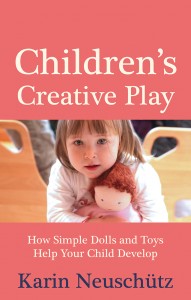Children’s Creative Play
by Floris Books • 26 March 2013 • Child Health and Parenting • 0 Comments
This practical book by Karin Neuschütz explores children’s developmental stages up to age seven, and suggests suitable toys, dolls, games and activities to nurture and develop them. In this extract, she introduces the ideas in the book, focusing on the importance of play for a child’s development and giving an overview of how children play at different ages.
Living Through Play
 As soon as children learn something new, they start to play with their new ability, practising and testing it. And as they develop, they tackle increasingly difficult tasks. Children who have just learned to walk start to take little dance steps; children who can talk start to sing and rattle off nonsense words; children who can dress themselves start to dress up or put clothes on backwards, just for fun.
As soon as children learn something new, they start to play with their new ability, practising and testing it. And as they develop, they tackle increasingly difficult tasks. Children who have just learned to walk start to take little dance steps; children who can talk start to sing and rattle off nonsense words; children who can dress themselves start to dress up or put clothes on backwards, just for fun.
A three-year-old girl who has recently understood that she is ‘I’ pretends she is someone else – a little squeaking mouse, or a baby. She is testing the limits of her own ‘I’ by changing roles.
As soon as children get used to their home and learn what rugs and furniture are for, they can’t wait to transform it, recreating the everyday into an adventure: the rug becomes an island, the floor an ocean, the chair a rowboat. The curtains are drawn and day becomes night. The shades go up and it’s morning already.
Children practise all skills through rhythmic repetition. It is through play that children enter into life. And all the time their eyes follow grown-ups in their activities – for one day they will also grow big.
The consciousness of five- and six-year-old children expands to the point where they can appreciate the bigger picture. They are interested in why we do the things we do, and they become more purposeful in their own activity. Everything they encounter in life is worked through in play. Whole worlds appear: schools, hospitals, families, theatres. Children at this age start to imagine what adults do, what life is ‘all about’.
Until the age of seven, children use a huge amount of energy just to control and come to terms with their bodies. Around seven this energy is then released, and can be used for imagination instead. Children’s memories develop; they can think more rationally, and think about the future. They are more aware of time. As they start school, they play games with rules and practise coordinating with other children.
Nine- and ten-year-olds are collectors. They want to understand how the world is organised, so they construct machines, draw houses in cross-section, develop factories and communication systems. They develop their own interests, becoming specialists and collecting facts. As they start to feel more grown up, they criticise adults more readily, often showing less respect and getting into trouble. It’s at this point that children effectively stop playing.
To summarise, the imagination-forces in young children are hard at work developing their physical bodies, growing and shaping the organism.
Their imagination is released as they turn six or seven and become more comfortable with their body. These forces can now be transformed into soul activities, creativity and sensitivity.
Out of this living imagination comes teenagers’ mental abilities, their clarity of thought and powerful ideas.
That’s a useful overview of how children play at different ages. But there are children who can’t play, who don’t want to or don’t have the energy to play, or who just rush and run around without being happy with what they are doing. How can we help them?
I believe that we always have to start with ourselves when we are trying to discover the reasons for a child’s disharmony. Our own state of being is the well from which children draw inspiration and joy of living. They hover near us in all that they do; they want to be like us in every way. To guide our children we must therefore start by attending to ourselves. If the people around a child are happy and active, the child will be too.
Taking the time to slowly and peacefully make a doll for a child can be a nice way to get close to him or her. As I sit and sew, I think about the child whose doll this will be. The child certainly senses the love and care that I ‘sew into’ the doll.
In this book I describe my own experiences of how children play at different ages, of how they are affected by their surroundings and by the people around them. My views have slowly come through work with my own and others’ children. I have learned a lot from my own childhood memories and through studies of child psychology and pedagogy – mainly works by Rudolf Steiner and many of his followers. I have picked up many things from today’s Steiner-Waldorf schools, and have tried to synthesise it all into a uniform whole.
This extract is taken from Children’s Creative Play. For more information, please visit the book page.
You may also be interested in:
You can discover more books by Karin Neuschütz on her author page. You might also be interested in more books on Parenting and Child Health.